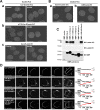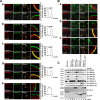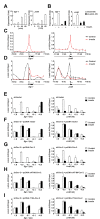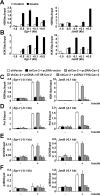Insulin-response epigenetic activation of Egr-1 and JunB genes at the nuclear periphery by A-type lamin-associated pY19-Caveolin-2 in the inner nuclear membrane
- PMID: 25753664
- PMCID: PMC4381080
- DOI: 10.1093/nar/gkv181
Insulin-response epigenetic activation of Egr-1 and JunB genes at the nuclear periphery by A-type lamin-associated pY19-Caveolin-2 in the inner nuclear membrane
Abstract
Insulin controls transcription to sustain its physiologic effects for the organism to adapt to environmental changes added to genetic predisposition. Nevertheless, insulin-induced transcriptional regulation by epigenetic factors and in defined nuclear territory remains elusive. Here we show that inner nuclear membrane (INM)-integrated caveolin-2 (Cav-2) regulates insulin-response epigenetic activation of Egr-1 and JunB genes at the nuclear periphery. INM-targeted pY19-Cav-2 in response to insulin associates specifically with the A-type lamin, disengages the repressed Egr-1 and JunB promoters from lamin A/C through disassembly of H3K9me3, and facilitates assembly of H3K9ac, H3K18ac and H3K27ac by recruitment of GCN5 and p300 and the subsequent enrichment of RNA polymerase II (Pol II) on the promoters at the nuclear periphery. Our findings show that Cav-2 is an epigenetic regulator of histone H3 modifications, and provide novel mechanisms of insulin-response epigenetic activation at the nuclear periphery.
© The Author(s) 2015. Published by Oxford University Press on behalf of Nucleic Acids Research.
Figures






Similar articles
-
A-type lamin-dependent homo-oligomerization for pY19-Caveolin-2 to function as an insulin-response epigenetic regulator.Biochim Biophys Acta. 2016 Nov;1863(11):2681-2689. doi: 10.1016/j.bbamcr.2016.08.011. Epub 2016 Aug 21. Biochim Biophys Acta. 2016. PMID: 27552914
-
Epigenetic regulation of Cebpb activation by pY19-Caveolin-2 at the nuclear periphery in association with the nuclear lamina.Biochim Biophys Acta Mol Cell Res. 2022 Dec;1869(12):119363. doi: 10.1016/j.bbamcr.2022.119363. Epub 2022 Sep 20. Biochim Biophys Acta Mol Cell Res. 2022. PMID: 36165916
-
Rab6-mediated retrograde transport regulates inner nuclear membrane targeting of caveolin-2 in response to insulin.Traffic. 2012 Sep;13(9):1218-33. doi: 10.1111/j.1600-0854.2012.01378.x. Epub 2012 Jun 11. Traffic. 2012. PMID: 22607032
-
Gene silencing at the nuclear periphery.FEBS J. 2007 Mar;274(6):1383-92. doi: 10.1111/j.1742-4658.2007.05697.x. FEBS J. 2007. PMID: 17489096 Review.
-
Synthesis, transport and incorporation into the nuclear envelope of A-type lamins and inner nuclear membrane proteins.Biochem Soc Trans. 2011 Dec;39(6):1758-63. doi: 10.1042/BST20110653. Biochem Soc Trans. 2011. PMID: 22103521 Review.
Cited by
-
Caveolae Mechanotransduction at the Interface between Cytoskeleton and Extracellular Matrix.Cells. 2023 Mar 20;12(6):942. doi: 10.3390/cells12060942. Cells. 2023. PMID: 36980283 Free PMC article. Review.
-
Intralipid protects the heart in late pregnancy against ischemia/reperfusion injury via Caveolin2/STAT3/GSK-3β pathway.J Mol Cell Cardiol. 2017 Jan;102:108-116. doi: 10.1016/j.yjmcc.2016.11.006. Epub 2016 Nov 12. J Mol Cell Cardiol. 2017. PMID: 27847332 Free PMC article.
-
Association of lamin A/C with muscle gene-specific promoters in myoblasts.Biochem Biophys Rep. 2015 Aug 29;4:76-82. doi: 10.1016/j.bbrep.2015.08.021. eCollection 2015 Dec. Biochem Biophys Rep. 2015. PMID: 29124189 Free PMC article.
-
A multistage sequencing strategy pinpoints novel candidate alleles for Emery-Dreifuss muscular dystrophy and supports gene misregulation as its pathomechanism.EBioMedicine. 2020 Jan;51:102587. doi: 10.1016/j.ebiom.2019.11.048. Epub 2019 Dec 17. EBioMedicine. 2020. PMID: 31862442 Free PMC article.
-
β1-Integrin Deletion From the Lens Activates Cellular Stress Responses Leading to Apoptosis and Fibrosis.Invest Ophthalmol Vis Sci. 2017 Aug 1;58(10):3896-3922. doi: 10.1167/iovs.17-21721. Invest Ophthalmol Vis Sci. 2017. PMID: 28763805 Free PMC article.
References
-
- O'Brien R.M., Granner D.K. Regulation of gene expression by insulin. Physiol. Rev. 1996;76:1109–11061. - PubMed
-
- O'Brien R.M., Streeper R.S., Ayala J.E., Stadelmaier B.T., Hornbuckle L.A. Insulin-regulated gene expression. Biochem. Soc. Trans. 2001;29:552–558. - PubMed
-
- Rome S., Clément K., Rabasa-Lhoret R., Loizon E., Poitou C., Barsh G.S., Riou J.P., Laville M., Vidal H. Microarray profiling of human skeletal muscle reveals that insulin regulates approximately 800 genes during a hyperinsulinemic clamp. J. Biol. Chem. 2003;278:18063–18068. - PubMed
-
- Lingwood D., Simons K. Lipid rafts as a membrane-organizing principle. Science. 2010;327:46–50. - PubMed
-
- Parton R.G., del Pozo M.A. Caveolae as plasma membrane sensors, protectors and organizers. Nat. Rev. Mol. Cell Biol. 2013;14:98–112. - PubMed
Publication types
MeSH terms
Substances
LinkOut - more resources
Full Text Sources
Other Literature Sources
Medical
Molecular Biology Databases
Miscellaneous

